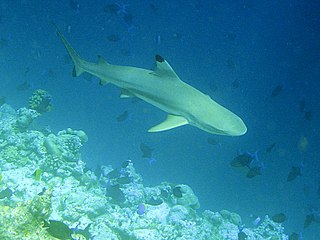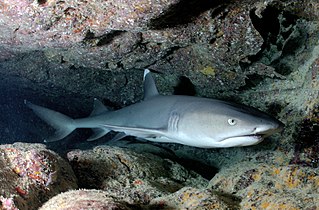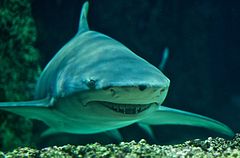
Requiem sharks are sharks of the family Carcharhinidae in the order Carcharhiniformes. They are migratory, live-bearing sharks of warm seas and include such species as the bull shark, lemon shark, spinner shark, blacknose shark, blacktip shark, grey reef shark, blacktip reef shark, silky shark, dusky shark, blue shark, copper shark, oceanic whitetip shark, and whitetip reef shark.

The grey reef shark or gray reef shark is a species of requiem shark, in the family Carcharhinidae. One of the most common reef sharks in the Indo-Pacific, it is found as far east as Easter Island and as far west as South Africa. This species is most often seen in shallow water near the drop-offs of coral reefs. It has the typical "reef shark" shape, with a broad, round snout and large eyes. It can be distinguished from similar species by the plain or white-tipped first dorsal fin, the dark tips on the other fins, the broad, black rear margin on the tail fin, and the lack of a ridge between the dorsal fins. Most individuals are less than 1.88 m (6.2 ft) long.

The blacktip reef shark is a species of requiem shark, in the family Carcharhinidae, which can be easily identified by the prominent black tips on its fins. Among the most abundant sharks inhabiting the tropical coral reefs of the Indian and Pacific Oceans, this species prefers shallow, inshore waters. Its exposed first dorsal fin is a common sight in the region. The blacktip reef shark is usually found over reef ledges and sandy flats, though it has also been known to enter brackish and freshwater environments. It typically attains a length of 1.6 m (5.2 ft). Like other sharks, the females are larger than the males.

The lemon shark is a species of shark from the family Carcharhinidae and is classified as a Vulnerable species by the International Union for the Conservation of Nature. Lemon sharks can grow to 3.4 metres (11 ft) in length. They are often found in shallow subtropical waters and are known to inhabit and return to specific nursery sites for breeding. Often feeding at night, these sharks use electroreceptors to find their main source of prey, fish. Lemon sharks enjoy the many benefits of group living such as enhanced communication, courtship, predatory behavior, and protection. This species of shark gives birth to live young, and the females are polyandrous and have a biennial reproductive cycle. Lemon sharks are not thought to be a large threat to humans; there have been 10 recorded bites, none of which were life-threatening. The lemon shark's life span is unknown, but the average shark is 25 to 30 years old. The oldest recorded lemon shark in captivity died in 2023 at the age of 40 years.

The whitetip reef shark is a species of requiem shark, in the family Carcharhinidae, and the only member of its genus. A small shark that does not usually exceed 1.6 m (5.2 ft) in length, this species is easily recognizable by its slender body and short but broad head, as well as tubular skin flaps beside the nostrils, oval eyes with vertical pupils, and white-tipped dorsal and caudal fins. One of the most common sharks found on Indo-Pacific coral reefs, the whitetip reef shark occurs as far west as South Africa and as far east as Central America. It is typically found on or near the bottom in clear water, at a depth of 8–40 m (26–131 ft).

The Ganges shark is a critically endangered species of requiem shark found in the Ganges River and the Brahmaputra River of India and Bangladesh. It is often confused with the more common bull shark, which also inhabits the Ganges River and is sometimes incorrectly referred to as the Ganges shark. The genus is currently considered to contain three recent species; genetic evidence has shown that both the Borneo river shark and Irrawaddy river shark should be regarded as synonyms of the Ganges shark, expanding the range of the species to Pakistan, Myanmar, Borneo, and Java. While the other members of the genus Glyphis occur in coastal marine waters as well as rivers, the Ganges shark is found only in fresh water, making it the world's only exclusively freshwater shark. The species remains poorly known and very rare.

The dusky shark is a species of requiem shark, in the family Carcharhinidae, occurring in tropical and warm-temperate continental seas worldwide. A generalist apex predator, the dusky shark can be found from the coast to the outer continental shelf and adjacent pelagic waters, and has been recorded from a depth of 400 m (1,300 ft). Populations migrate seasonally towards the poles in the summer and towards the equator in the winter, traveling hundreds to thousands of kilometers. One of the largest members of its genus, the dusky shark reaches more than 4 m (13 ft) in length and 350 kg (770 lb) in weight. It has a slender, streamlined body and can be identified by its short round snout, long sickle-shaped pectoral fins, ridge between the first and second dorsal fins, and faintly marked fins.

The horn shark is a species of bullhead shark, in the family Heterodontidae. It is endemic to the coastal waters off the western coast of North America, from California to the Gulf of California. Young sharks are segregated spatially from the adults, with the former preferring deeper sandy flats and the latter preferring shallower rocky reefs or algal beds. A small species typically measuring 1 m (3.3 ft) in length, the horn shark can be recognized by a short, blunt head with ridges over its eyes, two high dorsal fins with large spines, and a brown or gray coloration with many small dark spots.

The silvertip shark is a large species of requiem shark, in the family Carcharhinidae, with a fragmented distribution throughout the tropical Indian and Pacific Oceans. It is often encountered around offshore islands and coral reefs, and has been known to dive to a depth of 800 m (2,600 ft). The silvertip shark resembles a larger and bulkier grey reef shark, but can be easily identified by the prominent white margins on its fins. It attains a maximum length of 3 m (10 ft).

The blacknose shark is a species of requiem shark, belonging to the family Carcharhinidae, common in the tropical and subtropical waters of the western Atlantic Ocean. This species generally inhabits coastal seagrass, sand, or rubble habitats, with adults preferring deeper water than juveniles. A small shark typically measuring 1.3 m (4.3 ft) long, the blacknose has a typical streamlined "requiem shark" shape with a long, rounded snout, large eyes, and a small first dorsal fin. Its common name comes from a characteristic black blotch on the tip of its snout, though this may be indistinct in older individuals.

The spinner shark is a type of requiem shark, in the family Carcharhinidae, named for the spinning leaps it makes as a part of its feeding strategy. This species occurs in tropical and warm temperate waters worldwide, except for in the eastern Pacific Ocean. It is found from coastal to offshore habitats to a depth of 100 m (330 ft), though it prefers shallow water. The spinner shark resembles a larger version of the blacktip shark, with a slender body, long snout, and black-marked fins. This species can be distinguished from the blacktip shark by the first dorsal fin, which has a different shape and is placed further back, and by the black tip on the anal fin. It attains a maximum length of 3 m (9.8 ft).

The Australian blacktip shark is a species of requiem shark, in the family Carcharhinidae, endemic to northern and eastern Australia. Favoring the upper and middle parts of the water column, it can be found from the intertidal zone to a depth of 50 m (160 ft). Appearance-wise this species is virtually identical to the common blacktip shark, from which it can be reliably distinguished only by its lower vertebra number and by genetic markers. Generally reaching 1.5–1.8 m (4.9–5.9 ft) in length, it is a fairly stout-bodied, bronze-colored shark with a long snout and black-tipped fins.

Negaprion is a genus of requiem sharks in the family Carcharhinidae. It contains the two extant species of lemon sharks: the lemon shark of the Americas, and the sicklefin lemon shark of the Indo-Pacific. Both species are large, slow-moving, bulky sharks inhabiting shallow coastal waters, and can be identified by their short, blunt snouts, two dorsal fins of nearly equal size, and uniform yellowish brown or gray coloration.

The tawny nurse shark is a species of carpet shark in the family Ginglymostomatidae, and the only extant member of the genus Nebrius.

The Australian weasel shark is an uncommon species of ground shark in the family Hemigaleidae. It inhabits shallow waters off northern Australia to a depth of 170 m (560 ft); smaller sharks frequent sand and seagrass habitat and shift to coral reefs as they grow older. A slim, drab species reaching a length of 1.1 m (3.6 ft), it has sickle-shaped fins with dark tips on the second dorsal fin and caudal fin upper lobe. Its upper teeth are broad with strong serrations only on the trailing edge. The lateral line along each side is prominent and exhibits a downward curve below the second dorsal fin.

The sicklefin weasel shark is an uncommon species of ground shark in the family Hemigaleidae. It is native to southern India, southern China, and parts of Southeast Asia, living in shallow waters down to a depth of 170 m (560 ft). This lightly built shark is characterized by its very short mouth, broad upper teeth with serrations only on the trailing edge, and strongly sickle-shaped fins with obvious white tips on the two dorsal fins. It is light grey or bronze in colour, often with small white blotches on its sides; it reaches a maximum known length of 1.1 m (3.6 ft).

The Arabian carpetshark is a species of carpet shark in the family Hemiscylliidae, inhabiting coral reefs and other shallow coastal habitats from the Persian Gulf to India. Reaching 78 cm (31 in) long, this shark is characterized by a slender, plain brown body, and by two dorsal fins with straight trailing margins and the second smaller but longer-based than the first. The Arabian carpetshark feeds on bony fishes and invertebrates. Reproduction is oviparous with an annual cycle; females deposit egg capsules four at a time and the young hatch after 70–80 days. This small shark is often captured as bycatch but rarely used by humans. It has been assessed as Near Threatened by the International Union for Conservation of Nature (IUCN), as there is increasing fishing pressure and habitat degradation within its range. It does well in aquariums and has been bred in captivity.

Carcharias is a genus of mackerel sharks belonging to the family Odontaspididae. Once bearing many prehistoric species, all have gone extinct with the exception of the critically endangered sand tiger shark.

The pink whipray is a species of stingray in the family Dasyatidae, with a wide but ill-defined distribution in the tropical Indo-Pacific from southern Africa to Polynesia. It is a bottom dweller that generally inhabits shallow water under 70 m (230 ft) deep, in sandy areas associated with coral reefs. Individuals exhibit a high degree of fidelity to particular locations. The pink whipray has a diamond-shaped pectoral fin disc wider than long, with a broad-angled snout and a very long, whip-like tail without fin folds. It has only a few small thorns on its back and is uniform brownish to grayish pink in color, becoming much darker past the tail sting. This large ray can reach 1.8 m (5.9 ft) across and over 5 m (16 ft) long.

The lemon-striped pygmy hogfish is a species of ray-finned fish from the family Labridae, the wrasses. This species is found on reefs in the Coral Sea off the coast of Queensland and in French Polynesia.


























